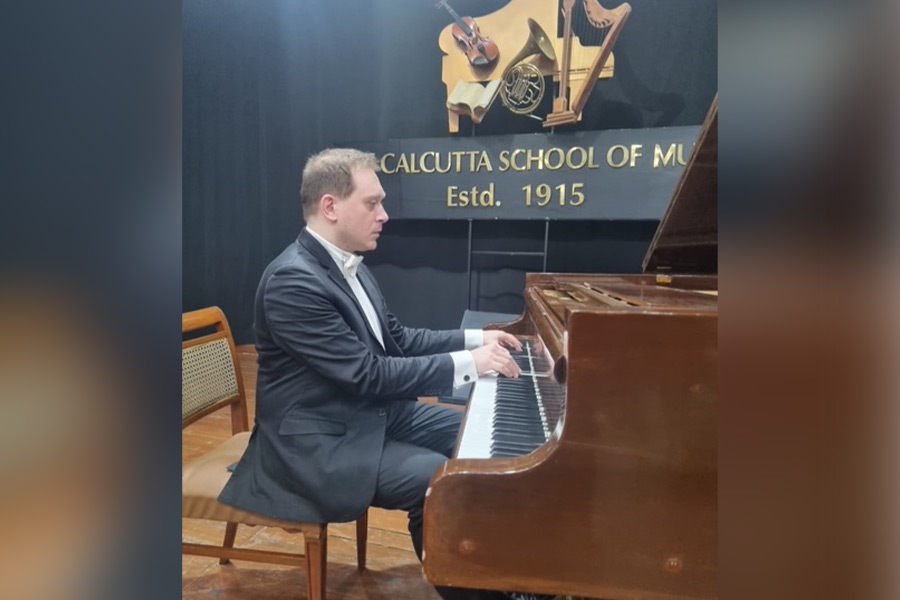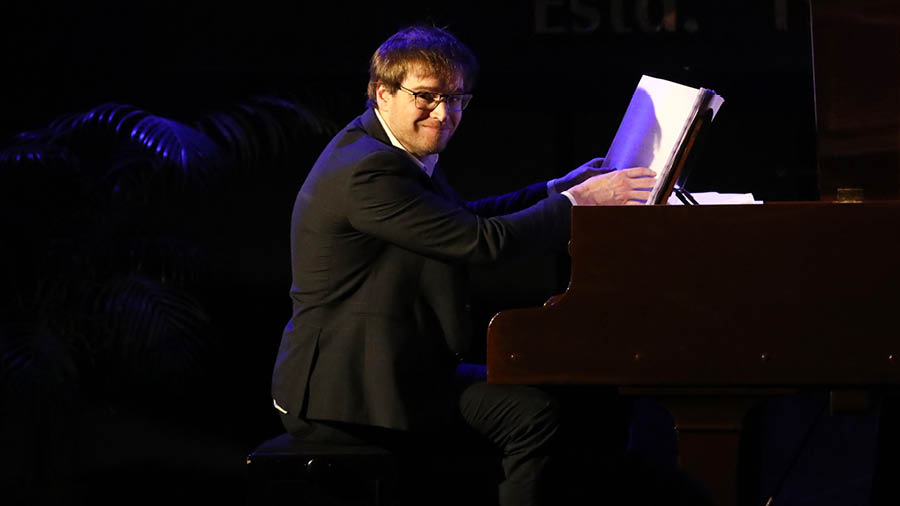From Cremona to Calcutta — there must have been some harmonic heartstrings attached. Cremona, a quaint city in Italy’s Lombardy region, is famous for the Stradivarius collection at its Museo del Violino, where handmade violins have been crafted since the sixteenth century, where the noted pianist Daniele Buccio lives and works, and who was in our city for a grandiloquent set of performances of all 32 Beethoven piano sonatas over two weekends this May.
The city’s western music cognoscenti could hardly believe that they could experience every sonata in the familiar surroundings of the Calcutta School of Music. And even for the opening evening at the Oberoi Grand, where the cocktails were just an appoggiatura, as the main brilliant performance gave them the first taste of the Great Sonata (No 4 in E flat major), lasting 28 minutes (one of the longest that Beethoven had composed) leaving everyone in anticipation of the next day’s more familiar Moonlight and Pastorale Sonatas.
A renewed chance to be ‘educated’
Buccio is a pianist of enormous unflagging energy and a fine dedication to his art. It is sheer passion and intensity that Buccio brought to bear on his playing that captivated the mixed audience of students, teachers, experts, and also those who have had occasion to hear the sonatas played by musicians in different parts of the world. Even for them, Buccio was a cinch, and for the music students and teachers, it gave them and the aesthetes a renewed chance to be “educated” into the 32 sonatas, and to glean the information and background provided in the programme notes, which added to the special dimension.

Buccio’s mastery captivated the mixed audience of students, teachers, experts, and also those who have had occasion to hear the sonatas played by musicians in different parts of the world. Even for them, Buccio was a cinch
On different days, the audience was enchanted by Buccio’s renderings of the more familiar Sonata Pathétique, one of Beethoven’s most celebrated compositions, written when he was 27 years old; the Appassionata, considered by the composer to be his most tempestuous piano sonata (and played with a frenzied fervour by Buccio); and the Waldstein, one of the notable sonatas of Beethoven’s middle period and also one of the most technically challenging. Such technicalities were executed with the brio of a performer possessed.
‘Separating the actual feelings of a performer’
While it was not possible to do any kind of an in-depth chat — seeing that an ardent student group needed their selfie, autograph and query time — I shared a set of questions on email. One of the questions I posed was which of the sonatas gave him real joy to perform — the Pathétique, the Waldstein or the Appassionata.
He expressed his feelings thus:
“I would be inclined to separate the representation of an ‘affective’ character, possibly impressed by the author in his work, from the actual feelings of a performer. For example, the ones arising when he struggles to let his own thinking coincide with the sensuous realisation, and privately evaluates how his means led to the result he has just obtained. Nevertheless, some of the titles of the Sonatas would explicitly evoke emotional states and seem to imply to regard the experience of the works as a tool to provide specific ones. The indications may reflect how these works were received during the 19th century and reveal positions on the relationship between represented effects and the actual appearance of musical feelings in the consciousness of a listener. In the case of the Sonata “Appassionata”, the title was not known by the author, as it appeared for the first time in 1838 in a transcription of the work for piano four-hands published by the editor Cranz in Hamburg. On the contrary, the title of “Pathétique” was chosen by the publisher Hoffmeister and confirmed by the author in 1799.”
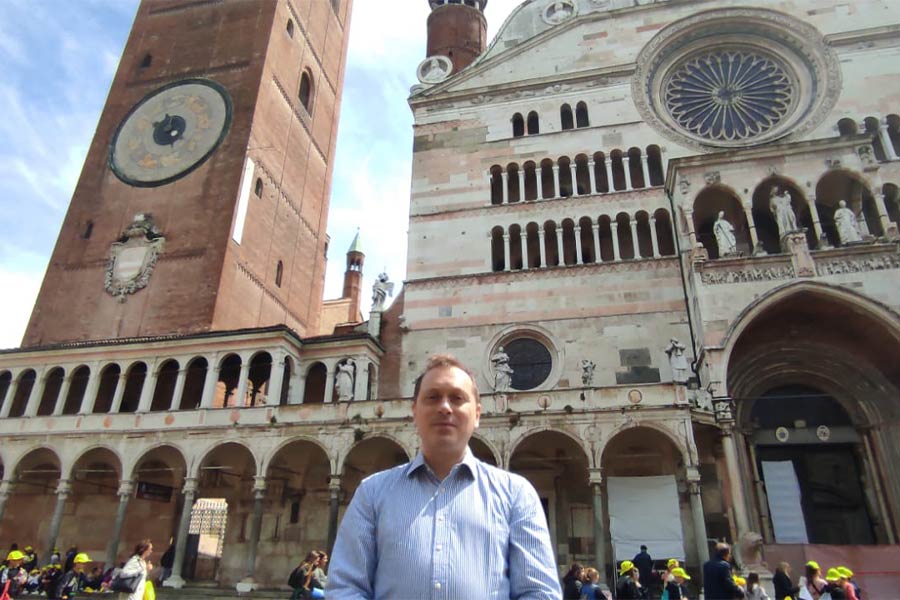
Buccio at the Piazza del Duomo in Cremona, Italy
We wanted to know which of the sonatas was the most challenging for Buccio to tackle — possibly the Piano Sonata No 29 in Bb major — the Hammerklavier. (Literally hammer keyboard). It came to us on the final evening, a difficult sonata to comprehend and for the pianist, possibly a huge mountain to overcome technically.
“Every sonata carries with itself therefore two centuries of performance tradition, and of thoughts expressed and realised by pianists of all backgrounds and from all musical contexts. Difficulties can mainly vary and depend on performers’ goals and purposes. The “Hammerklavier” Sonata op. 106, composed between 1817 and 1819, represents a unique work within the genre, as it was designed with the most extended and ambitious form in four movements. At the time of its first publication, the author and the editor were well aware of the consequences of the work for the reception among the public and for the performers; it would have taken time to be fully appreciated and realised. The first bars of its Adagio were ‘quoted’ by Franz Liszt, who very successfully performed the sonata in Paris in 1836, in his second Beethoven-Kantate S.68, a choral homage he composed for Beethoven’s centenary anniversary in 1870.”

‘Every sonata carries with itself therefore two centuries of performance tradition, and of thoughts expressed and realised by pianists of all backgrounds and from all musical contexts,’ said Buccio
There were moments of enlightenment for various attendees. For Chitra Bir, a music enthusiast, and one time pianist, she was over the moon when he played the Piano Sonata No 24 in F# major — nicknamed “à Thérèse”, because it was a Grade 8 piece she had played when she was in school. I urged her to renew it!
For Dickoo Nowroji, music connoisseur and pianist, formerly president of the Calcutta School of Music, who found the performances professorially rendered, it was the unconventional Piano Sonata in A Flat major with its four movements that resonated.
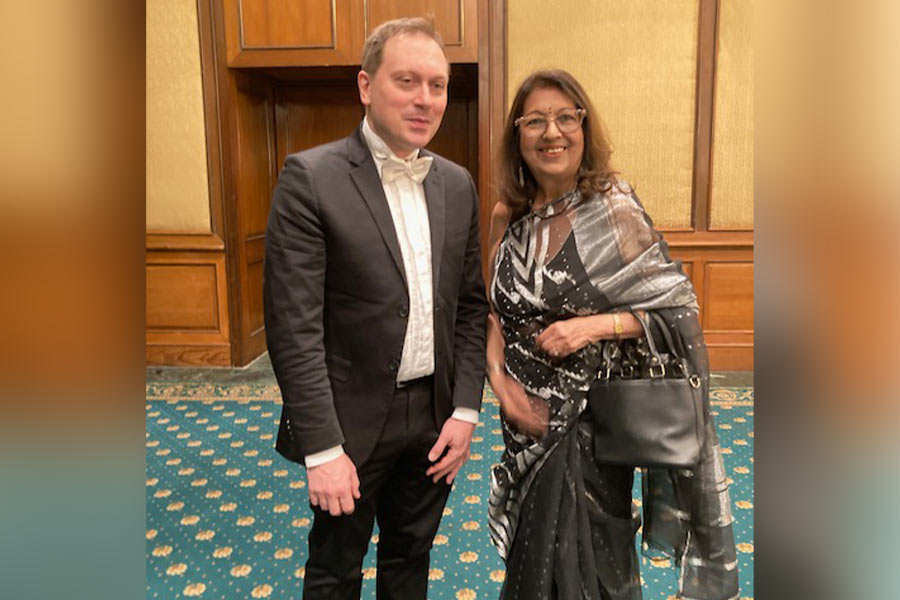
The author with Buccio at the opening concert
The crux of it all was what the students gained. Having started out himself at the age of five, it was Buccio’s masterclasses given in Kolkata that saw a “strong commitment from each student and a keen desire to understand how to surpass the current limits.” The students would also have noticed his total humility, after each concert, when he would quietly take a bow and shyly smile at the audience.
‘Mesmerising’ taste of Beethoven
Behind it all was Jyotishka Dasgupta, the current president of the Calcutta School of Music, who has helmed C4, a music initiative where there is no compromise in teaching standards, and who is a noted music composer for award-winning films. He had earlier brought the same performer to give Kolkata a selection of Chopin’s 24 Preludes, and this time around, Kolkata got its “mesmerising” taste of Beethoven.
In Kolkata, on the sidelines, he visited Jorasanko and as for Bengali cuisine, he found it “lively full of taste, and intense discoveries.”
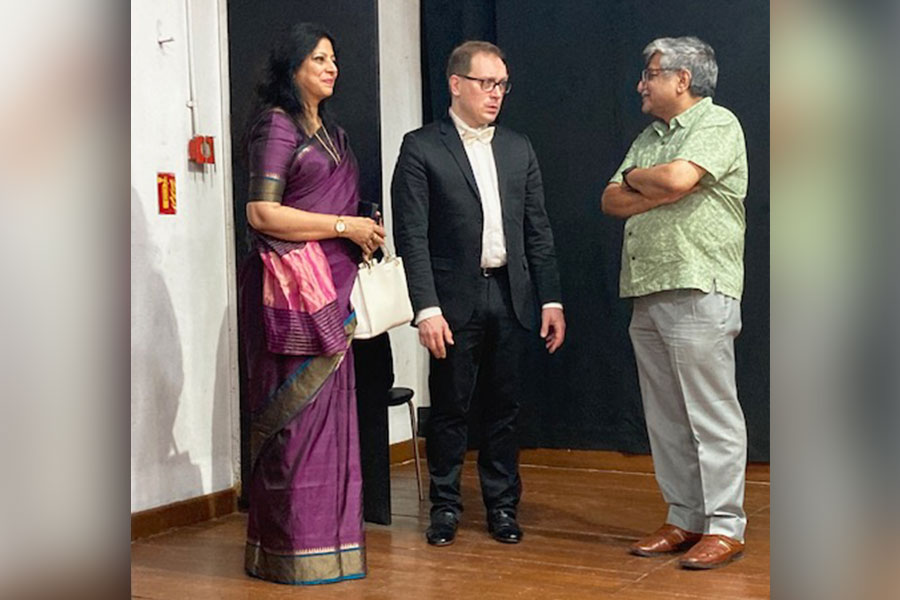
Buccio with (right) Jyotishka Dasgupta and Chaitali Ganguli
Back in Cremona, for Daniele Buccio, it is his professioral side that kicks in, preparing himself as he does for musical commitments and events, and carrying out musicological and compositional works. Many in this city would have liked to have heard his performance of all of Beethoven’s symphonies, which Buccio had presented in their entirety in a “cycle over four afternoons in the Museum Čiurlionis in Kaunas.” It is incidentally one of the largest and oldest museums in Lithuania. He performed the 9th Symphony in New Delhi, in 2022.
A nugget that one cannot but share — on May 7, exactly 200 years ago, in 1824, the Ninth Symphony debuted in Vienna. Beethoven, who had lost his hearing abilities, nevertheless was there to “conduct”, although there was an actual conductor present. Since he couldn’t hear the applause at the end, one of the singers made him turn to face the audience when he got five standing ovations.
